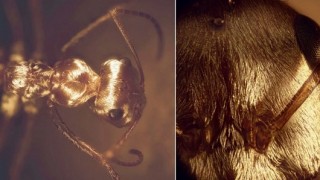
Researchers have recently discovered that Saharan silver ants are capable of adapting to the most extraordinary conditions. Tasked with scavenging, everyday, at peak temperatures of around 160 degrees Fahrenheit, these tenacious insects have a secret weapon to combat the extreme heat: metal-like strands of hair.
If the body of the silver ant (Cataglyphis bombycina) were to exceed 128.48 degrees Fahrenheit, the insect experiences irreversible damage and dies. However, scientists at Columbia Engineering have discovered that the eusocial insect’s unique adaptation has ensured it is capable of withstanding the blistering temperatures of the African desert, with the critters making scavenging runs every 10 minutes.
Initially, the researchers were struck by the ants’ strange appearance. In full daylight, they had the appearance of small mercury droplets. At near-infrared light, the Saharan ant’s hair coating serves a reflective function. Intriguingly, the strands of hair can serve emissivity purposes in the mid-infrared spectrum. This anti-reflective specialization allows the ants to shift their own body heat - passing it onto the cool air surrounding it - via blackbody radiation.
“We quickly realized these two effects are actually helping each other,” explained the assistant professor of applied physics at Columbia, Nanfang Yu. “The combination of this tool leads to the optimum cooling effect.”
According to the study, the ants lead a lifestyle of “thermophilic scavenging,” looting the surrounding desert for the carcasses of dead creatures, in the intensely hot mid-day sun. This is made possible because of a series of triangular-shaped hairs, densely arranged along the insects’ skin. The hairs grow straight upwards, before turning at a 90 degree angle. This provides a small space between the hair and the skin, which creates the cooling effect.
The ants also possess other novel adaptations that allow them to withstand the scorching temps. ), In anticipation of the extreme heat, they release heat shock proteins (HSPs) that ensure regular cellular functions continue. They also have longer legs, lifting their bodies away from the hot sand, and only use four out of six legs when sprinting across the desert.
In looking at the possible applications of their research, Yu and colleagues have considered the possibility of developing heat-tolerant “metasurfaces.”
“This is very clever engineering on how to deal with high temperatures,” stated Yu. “In engineering terms, this is the best you can do in terms of cooling down an object without using any electricity.”
The study, entitled Keeping cool: Enhanced optical reflection and heat dissipation in silver ants, was published in the June 18 issue of the journal Science.
Top image credit: Norman Nan Shi, Nanfang Yu/Columbia Engineering
